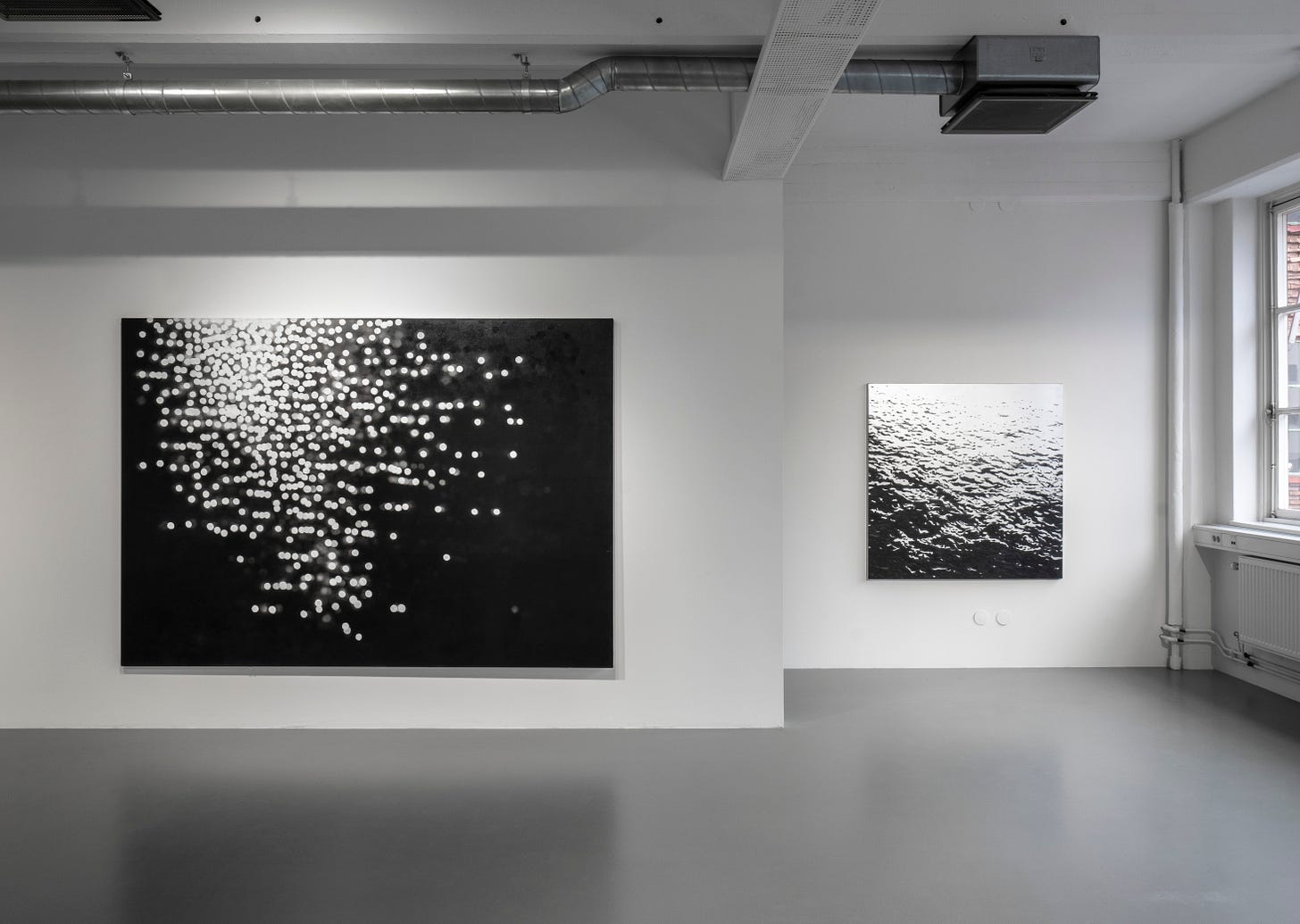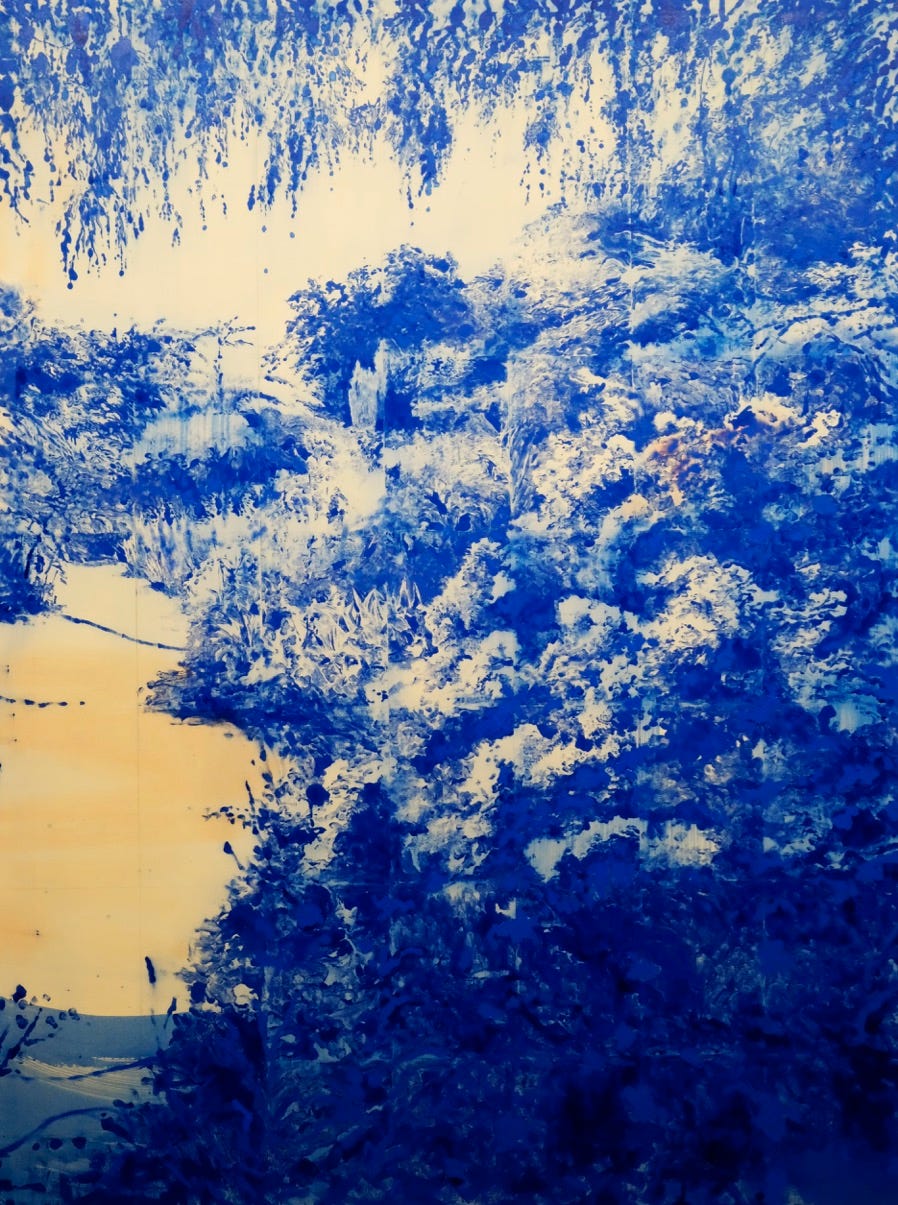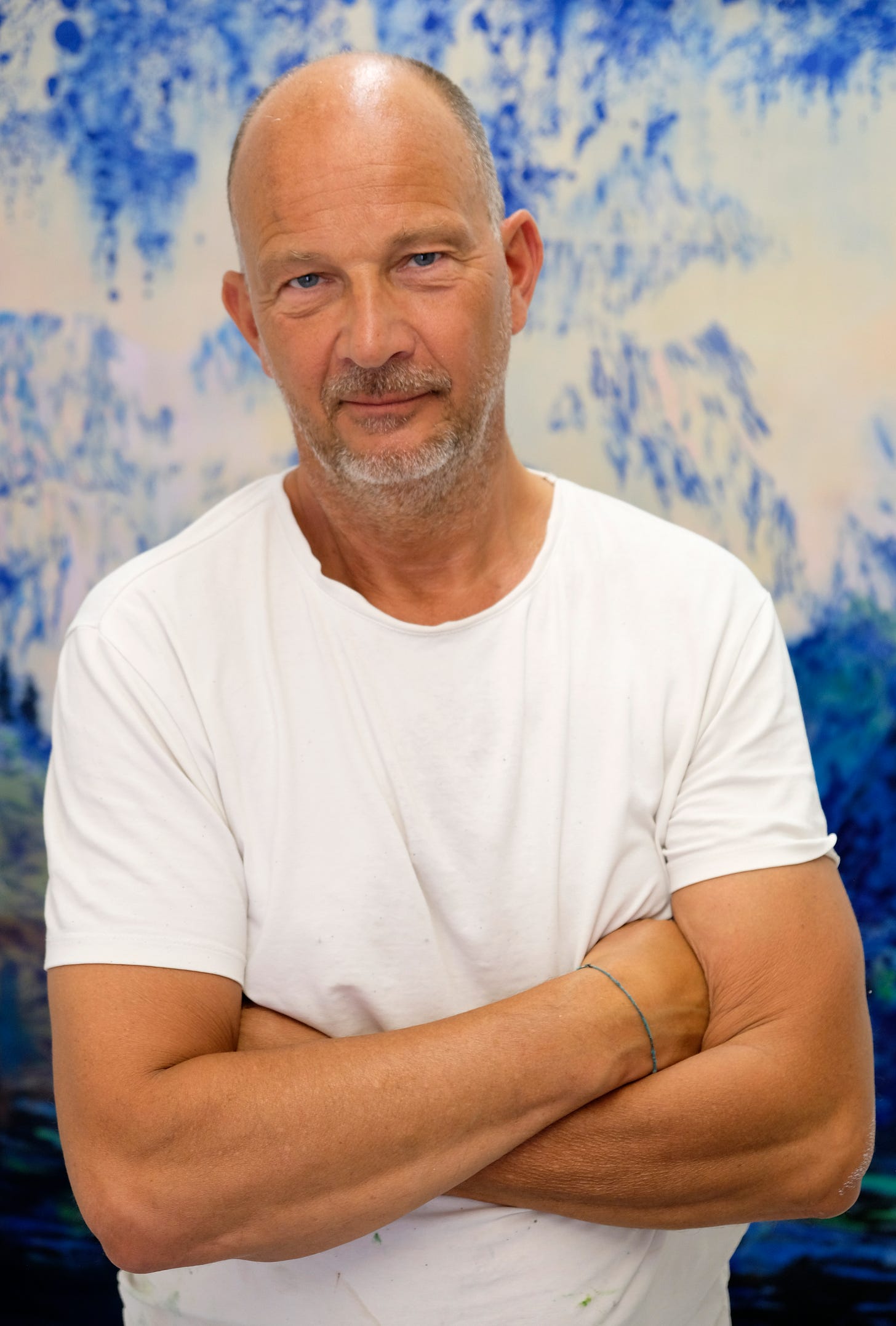A Pixelated World
Tarantula Authors And Art's Inspiration For August, Joakim Allgulander
Early in May, I walked into Galleri Duerr in Stockholm’s industrial Gallery District and was immediately captivated by the oversized landscapes that covered the walls of this lovely space. Nature's romanticism may have been the first thought that came to mind; ; one piece even reminded of Toile de Jouy, the 18th century fabric that was usually printed in one color (black, blue or red) and portrayed pastoral scenes, vignettes with people from French farms, European myths. Beautiful or a carefully crafted story? Then my attention shifted to the fluorescent light rods juxtaposed to the first two large green canvases, creating somewhat of a greenhouse effect. In the second room, hang a few smaller paintings depicting black trash bags next to nature and abandoned old car tires implying that there is more going on than what the naked eye perceives.
Deborah Duerr, the gallery owner, enthusiastically approached me and my fellow writer, Lidia Oshlyansky, who had joined me on a gallery tour that afternoon, and encouraged us not to rush through Joakim Allgulander’s work. She unveiled the stunning landscapes, and showed us the grids that go through the paintings probing us to wonder whether or not what we are looking at was natural at all?.Are we potentially looking at our screens instead, just enlarged? Or does Allgulander have super vision and using pixillation, he focuses the viewer’s attention not on the sky, but closely on the gases and pollution that forms it. A cloud is not just a cloud anymore, but a combustion of human waste as well as chatter.
“Green, Black and Blue” at Galleri Duerr was Allgulander’s first solo show in his hometown, Stockholm, in ten years. After completing his studies at Konstfact, one of the most famous art schools in Stockholm as well as Ölands Folkhögskolam, he relocated to Sweden’s biggest island Gotland. He worked and lived there for many years before moving on to London, and eventually to Italy where I tracked him down to conduct this interview.
Maja Milanovic: I saw your exhibition “Green, Black and Blue” at the Duerr Gallery in Stockholm, Sweden, so let’s start with that. When you entered the gallery, the first thought was that you are surrounded by beautiful landscapes and oversized plants, only to realize that all is not lush and perfect. The garden is not really a garden or is it? It’s also pixalized and we leave the exhibition questioning what is real and are we even part of nature anymore. When did this show start to take shape?
Joakim Allgulander: The exhibition at Galleri Duerr started to take shape about a year ago when Deborah Duerr and I started a conversation about doing an exhibition in Stockholm. The theme of the show is something I´ve been working on long before this, but when I saw the gallery space, I decided to make pretty big paintings and also not to work in series which I have done a lot before. I have always been interested in contradictions: light and darkness, good and evil, life and death and such. In these new works, it was a bit more sublime and not so obvious. There is an environmental critique in the works, but also it is very much about how they are made, I wanted the process to be a part of the message.
My colleague Lidia visited the exhibition with me and she wanted me to ask you “What first made you sense the disconnectedness and distance that we place between us and nature? When did you first start feeling this yourself?
I think that the disconnectedness or distance from nature (or other things) is not based on a feeling more a matter of fact. Most people have secondhand experiences as a result of various forms of media. I've noticed that contemporary painting is currently very much about incorporating photographs in some form or another, particularly in Sweden.
I use photographs a lot in my practice - I´m Swedish after all, haha. For these paintings, I collected photos of plants, botanical gardens, clouds, smoke, water among other things and did collages with my own photos and drawings combined with images I found on the internet. Human created environments which I then painted.
On the other hand, I would also add that only the chat clouds in the painting entitled “Chat Clouds” are exactly what we think they are and chatter is overtaking our everyday lives.
The chat room. Yes. It was good that the painting “Group Chat” had its own room because I realized that this work was a little off topic in this exhibition. As in most of my works, there are landscapes involved in some way, even in this painting, which is based on thousands of empty speech bubbles forming a shape of a cloud or a reflection in water or whatever you imagine it to be really. I thought it was interesting to build something from a little symbol, and because it is a speech bubble that is also empty, it becomes something like a constant ongoing conversation or chatter about all or nothing.
The gallerist Deborah Duerr shared with us an anecdote that when you placed the “Group Chat” painting in the little separate room of the gallery, the wall next to it was empty, so you went back to the hotel room and painted a few of the smaller paintings.
The painting seemed a little lonely in the room, so I created a series of watercolours on the same theme in my hotel room, which worked quite well, and it was liberating to make some works on the spot, something I don't usually do.
You also talk about how your technique for this exhibition was different. Can you tell our readers a little bit about the new process?
I've created numerous print editions, including litographs, screen prints, and digital prints. I like the technique of creating a print layer by layer, color by color, so I started applying it on my original works - the paintings. As previously mentioned, I wanted the method to be visible and part of the message. In the paintings "Blue Morning" and "Grid," for example, I divided my reference image into multiple squares - basically a typical grid enlargement but also referencing to pixelated jpeg photos - and then used a plastic sheet to monoprint each square on to the unprimed cotton canvas. By building up the image in this highly controlled manner, I felt as if I were "constructing" a landscape painting in the same way as a greenhouse or landscape architect works. The end result is a printed surface over which I don't have complete control due to how the paint blurs, and on which I then freely paint and apply washes in various ways.
In many ways it feels that with this exhibition you departed from your previous works and not just in technique. In some of your earlier interviews you stated that you are not a narrative painter but focus on motif. “Green, Black And Blue” is definitely storytelling, it even has a story within a story, the story of “Moby Dick” in your black and silver painting entitled the same. Using black and silver across the whole canvas to depict the big blue is an interesting choice.
The painting “Moby Dick” is also about building up something with a method or by mark making, in this case dots. I was studying how light reflects on water and made a lot of sketches with only white dots on black paper and bokeh effects. Also, I tried different surfaces like very shiny lacquers against very matt colours and textures which resulted in the painting “Black Ocean” in which textured matt black colours and a shiny silver car lacquer depicts sea waves. In the big painting, “Moby Dick” (170x240 cm), I painted the entire thing black and then began removing paint dot by dot. In between each layer, I painted another wash with black paint, doing this numerous times to create depth, and eventually adding white dots on top. The title "Moby Dick" came later; I thought it was a good title because of the large size of the painting and the slightly eerie sense you get when looking down in dark water and wondering what's beneath the surface. In addition, the book describes man's fear and love of nature and the elements.
Going back to your earlier works, you frequently used recognizable motifs that can make us nostalgic for a world we are leaving behind. Despite this, their bright colors give them a sci-fi vibe. Do you consider yourself an archivist or a futurist?
Hm, neither. But I have often used a kind of nostalgic approach but I think it is more about understanding the time we are living in now, to put it in perspective.
Sometimes, as in your piece “Rocket Man,” you portray a recognizable image, such as an astronaut walking on a planet. But then you discover in the reflection that the rocket man isn't alone in his conquest. A couple dressed in summer clothing has parked their vacation trailer on the planet. How significant are humour/absurdism and surprise to you?
I used to work with humour and absurd ideas when I was doing sculptures and installations, and some of that is still present in some of the printed editions. Humour is probably underappreciated in art, yet it is a great way to convey a message.
For someone who says that you are not a narrative painter, it seems like you are constantly trying to tell us something through a story.
I believe my story will tell you what it is like to be a human being in this world from various perspectives. I am not a narrative painter in the sense that I tell a story within each painting, but rather an overall story or topic.
Also, the choice of material, colour or technique tell stories or refer to different things.
Is environmentalism something that you will continue to explore in your work?
I'm not sure, but it's most likely in some form. I wouldn't describe myself as an environmentalist, but I am rather pessimistic about how we explore the environment. Art could serve as an escape from all of this, but I can't picture me painting unicorns or mythical creatures, so probably yes.
A more of a general question, how does inspiration come to you?
I am pragmatic and my ideas come from my work and the urge to create or paint something. I could see something, anything, that inspires me to paint or create, and then these works lead to the next and the next.
You were born in Sweden but lived in England and now in Italy? How does each place affect you as an artist? Or does it?
I lived eight years in London and the past two years in Italy. Prior to that, I lived on Gotland for 14 years; I was born in Stockholm but grew up in Hällefors and Bergslagen, so I've lived in many different places. I believe that every place offers something; for an artist, it's like having a large candy box full of experiences to use as you choose; the more experiences you have, the better. In London, for example, I had a studio in busy East London and found myself painting landscapes from my childhood in Bergslagen. It was perhaps a reaction to the big urban city, but it was also a way for me to find myself. So, yes, the place has an impact on you but maybe not in the way you expected.
What are you working on now?
I am now working on a large commission for The Dorchester Hotel in London. A big renovation is being made in the famous five-star hotel, and an art advisory discovered my work and requested that I create 26 paintings for the new suites based on a Linescape I created 20 years ago! You never know where your work will take you. I recently had a work in a group show at London's Saatchi Gallery for the second time, and I am preparing to show work for a German gallery that has approached me.
Where can our readers learn more about you?
Galleri Duerr has a good presentation on their home page and I try to keep my own updated. I am also on Instagram as @allgulander1
Thank you so much for you time!







